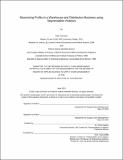| dc.contributor.author | Darmesh, Aidar | |
| dc.contributor.author | Mantellini Bracho, Ramón Alberto | |
| dc.date.accessioned | 2021-06-16T17:02:01Z | |
| dc.date.available | 2021-06-16T17:02:01Z | |
| dc.date.issued | 2021-06-16 | |
| dc.identifier.uri | https://hdl.handle.net/1721.1/130961 | |
| dc.description.abstract | In 2019 most of sponsor company’s transactions came from its freight forwarding service. Due to strategic alliances between retail giants and freight carriers, the profit margins of independent freight forwarders are being squeezed. To survive the company needs to ensure that its warehousing and distribution services are sufficiently profitable. However, company’s existing accounting methodology does not show profitability by operations. This project develops a transaction-level cost and revenue allocation model and applies a profit-mapping technique to identify profitability of the business units, customers and services. A more granular analysis revealed the key profit levers which can be deployed to grow company’s profits. The profit mapping showed that most customers responsible for higher-than-average gross margins do not have higher profits due to intensive use of fixed-cost resources. To maximize profits the company should target reduction of specific cost items, bundle unprofitable services with profitable ones, and exercise caution in pruning customers. | en_US |
| dc.language.iso | en_US | en_US |
| dc.rights | CC0 1.0 Universal | * |
| dc.rights.uri | http://creativecommons.org/publicdomain/zero/1.0/ | * |
| dc.subject | Data Analytics | en_US |
| dc.subject | Warehouse | en_US |
| dc.subject | Supply Chain Strategy | en_US |
| dc.title | Maximizing Profits in a Warehouse and Distribution Business Using Segmentation Analysis | en_US |
| dc.type | Other | en_US |
